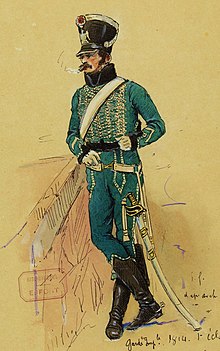1 he regiment des éclaireurs de la Garde impériale
The 1 er régiment des éclaireurs de la Garde impériale was a unit of the light cavalry of the Garde impériale of the Napoleonic Army during the coalition wars . Erected in 1813, it was dissolved again in the course of the first restoration in 1814. During the retreat in the Russian campaign , the Grande Armée was heavily harassed by Cossacks . The regiments of the light cavalry were better able to cope with this than the heavy cavalry like the Grenadiers à cheval or the Dragoons .
Very impressed by this, Napoléon ordered the formation of the Éclaireurs de la Garde impériale to three regiments as a counterweight to the Cossacks on his return to France .
Lineup
Due to the dramatic prospects after the first battles on French soil since the Revolutionary Wars, Napoléon felt compelled to reorganize his guard from December 4, 1813. Article 1 of the decree ordered the establishment of the “Éclaireurs de la Garde impériale”. Eventually three regiments were realized. The 1st regiment was assigned to the "Grenadiers à cheval de la Garde impériale" with the designation "Régiment des éclaireurs-grenadiers".
Commanders
The first regiment was subordinated to Colonel Claude Testot-Ferry , who had been seconded by the Dragons de l'Impératrice , had previously held a position as aide de camp for Maréchal Marmont and had attracted the emperor several times.
The unit consisted of four escadrons of 250 men each with the escadron commanders:
- Chef d'escadron Pierre, formerly in the 10 e régiment de chasseurs à cheval and with the chasseurs à cheval de la Garde
- Chef d'escadron Delavillane
- Chef d'escadron Lepot, from the Grenadiers à cheval de la Garde
- Chef d'escadron Kister
The majority of the officers came from the Imperial Guard.
Uniforms
The uniform of the 1st Escadron (awarded the title of Old Guard ) was largely based on a hussar uniform, as it was worn by the Gardes d'honneur - dark green dolman with white lacing.
The three other escadrons ( belonging to the Young Guard ) wore the uniform of the "Chasseurs à cheval de la ligne" ( hunters on horses of the line) with a short, green vest, also known as "Kinski".
Calls
Due to the late installation in 1813, the unit was no longer used that year. It only took part in the campaign in France in 1814 and was after the return of Louis XVIII. dissolved. It was used on:
- January 29th at the Battle of Brienne
- February 1st in the battle of La Rothière
- February 10th in the Battle of Champaubert
- February 11th at the Battle of Montmirail
- February 18 at the Battle of Montereau
- March 7th in the battle of Craonne
- March 20-21 in the battle of Arcis-sur-Aube
The most important action of the unit was the removal of Prussian artillery batteries in the battle of Craonne, much to the delight of Maréchal Ney and the emperor. Colonel Claude Testot-Ferry was personally appointed Baron of the Empire on the battlefield of Napoléon.
literature
- Alain Pigeard, Vincent Bourgeot: La Cavalerie de la Garde Impériale. Soteca, 2013, ISBN 979-10-91561-58-7 .
- Alain Pigeard: Les différentes unités de l'armée du duché de Varsovie - Krakus. In: Tradition Magazine. No. 8: Napoléon et les troupes polonaises 1797–1815. De l'Armée d'Italie à la Grande Armée. January 1999.
- Jean Brunon, Raoul Brunon; Pierre Benigni, Louis Frégier (Ill.): Les éclaireurs de la Garde impériale. 1813–1814 ( memorial from March 25, 2019 in the Internet Archive ). Collection Raoul et Jean Brunon, Marseille 1962, OCLC 67376767 (PDF; 3 kB).
- Gérard Jaeger: Les éclaireurs de la Garde impériale. In: Tradition Magazine. No. 164, 2001.
- Jean Tranié, Juan-Carlos Carmigniani: Napoléon 1814 - La campagne de France. Pygmalion / Gérard Watelet, 1989, ISBN 978-2-85704-301-0 .
- François-Guy Hourtoulle, Jack Girbal, Patrice Courcelle: Soldats et uniformes du Premier Empire. Histoire & Collections, Paris 2004, ISBN 978-2-913903-54-8 .
- Ronald Pawly, Patrice Courcelle: Napoleon's Scouts of the Imperial Guard. In: Men-at-Arms. No. 433, 2006, Osprey Publishing, ISBN 978-1-84176-956-1 ( limited preview in Google Book Search).

